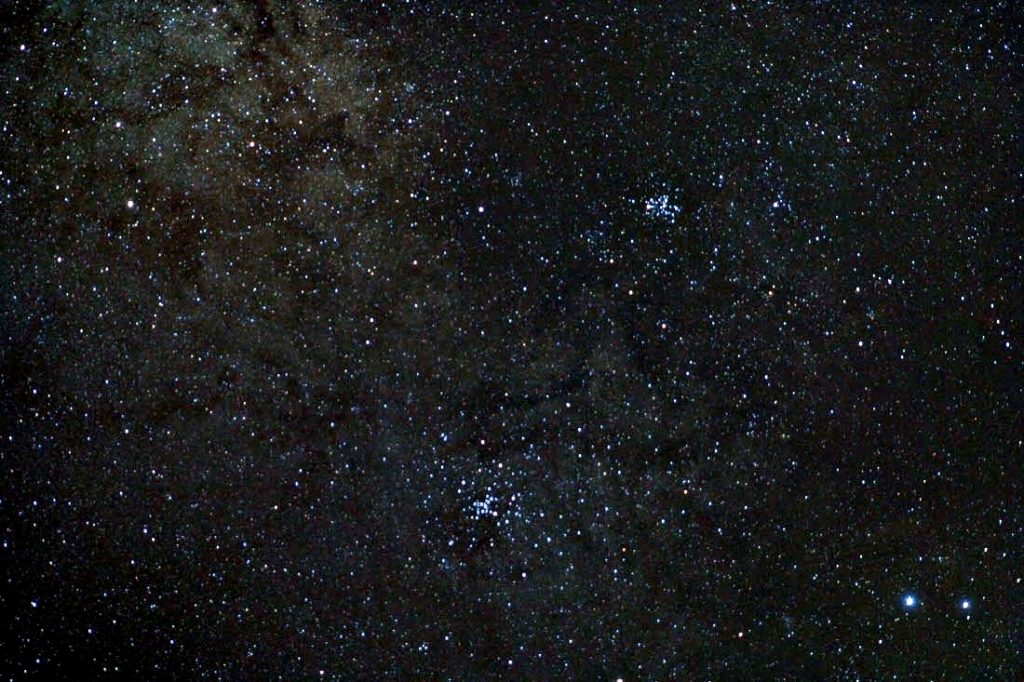
M6
Alternate: NGC 6405, The Butterfly Cluster
Scorpius
RA 17h 40.1 m
Dec -32º 13′
Magnitude 4.2
M7
Alternate: NGC 6475, The Ptolemy Cluster
Scorpius
RA 17h 53 m 51.2 s
Dec -34º 47′ 34”
Magnitude 3.3
The Pipe Nebula
Alternate:Barnard 59, 65, 66, 67, and 78
Scorpius
RA 17h 27 m
Dec -26º 56′
Magnitude: dark nebula
This cosmic duet is not only a binocular pair, but under dark skies can be seen with the naked eye.
Both M6 and M7 are open clusters in the Scorpius. The M7 is detectable without optical aid and is located near to the tail stinger of Scorpius, the Scorpion. M7 is the southernmost object in the Messier catalog. M6, being slightly dimmer, can also be seen with the naked eye nearby. Dark country locations will enable naked eye sittings of M6 and M7. Suburban and urban observers need not apply.
The ancient Greeks knew of M7. It was first recorded by the 2nd-century Greek-Roman astronomer Ptolemy, who described it as a nebula in 130 AD.This is how M7 gained the nickname of Ptolemy’s Cluster. Some astronomy historians think that Ptolemy may have also observed M6, but he did not record that observation.
Italian astronomer Giovanni Batista Hodierna observed M7 before 1654 and recorded it containing 30 stars. In 1654, Hodierna observed and recorded the Butterfly Cluster. Hodierna published in 1654 a book that contained his catalog of non-stellar objects, but this work apparently was unknown to Charles Messier. In 1764, the Butterfly Cluster and the Ptolemy Cluster became the sixth and seventh members of Charles Messier’s famous catalog.
There is some disagreement on the Trumpler classification of M6. Trumpler has classified M6 as II,3,m, while the Sky Catalog 2000.0 gives its Trumpler type as III,2,p. Other sources have listed M6 as II,3,r.
M6 is estimated to be around 100,000 million years old. Most of the bright, visible stars in it are hot, young, blue stars belonging to the spectral class B4-B5. However, the brightest star in the cluster is an orange giant belonging to the spectral class K.
The brightest star in M7 is a yellow G8-type giant with an apparent magnitude of 5.6.
Observations of M7 reveal about 80 stars within a field of view of 1.3° across. M7’s estimated distance of 980 light-years, and approximately 25 light years across. The age of the cluster is around 200million years while the brightest member star is of 5.6 magnitude. M7 is classified as of Trumpler type I,3,m or I,3,r.
The two Messier clusters can be easily observed through 2.1×42, 7×50, and 10×50 binoculars, even under slightly light-polluted suburban skies. M6 and M7 are separated by 6º, making telescopic duet observing virtually impossible.
As a special added attraction, a dark nebula can be detected under dark skies in the M6/M7 region. The famous Pipe Nebula on the Scorpius / Ophiuchus border, lies north of M6 and M7. The Pipe Nebula is also known as Barnard 59, 65–67, and 78. The Pipe Nebula is a dark nebula of light obscuring dust and gases in the Ophiuchus and is part of the larger Dark Horse Nebula. It is a large but readily apparent pipe shaped dust lane that obscures the Milky Way star clouds behind it. Clearly visible to the naked eye in the southern United States under clear dark skies, it is best viewed with 7×50 or 10×50 binoculars. Observing dark nebulae requires the special skill that is opposite of a sky observer’s normal observing process. Instead of recognizing where stars and nebulosity is, the goal is recognizing where stars aren’t.